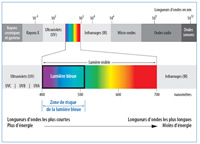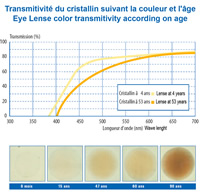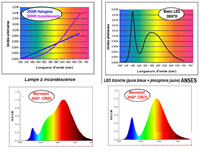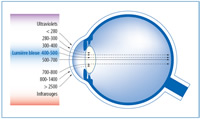Search
No products
Product successfully added to your shopping cart
There are 0 items in your cart. There is 1 item in your cart.
Led & Santé
A recent study from the French Health and Security Agency stigmatise security problem on Led domestic light.
2 problems are identified in the report
A too strong luminance.
This illustrates the fact that looking directly a bulb is dazzling, and creates eye trouble. The more important is light intensity and concentration, the more serious and lasting are the troubles.
For the same lighting power in lumen, the larger is the emittting surface, the lower is the luminance, and the lower is the danger .
These risks are real with Led bulbs ( certainly over 3W power) and especially if light is produced by a Monoled with a high luminance ( in lumen/mm2) If we take the example of 2 2W bulbs both delivering 140 lumens , one a Monoled with a 5050 cms chip ( 5mmX5mm) , the second based on 12 5050 cms chips On the Monoled we have a luminance of 140 lm/25mm2 = 5,6 lm/mm2 , for the second bulb the luminance is 140 lm/25mm2 = 0,46 lm/mm2.
The muliple Led bulb is for this reason preferable to the Monoled, in terms of eye safety.
Blue light toxicity.
The white light is the addition of various radiations which go from blue to the red for the visible spectrum. ( See pic 1 )
The blue light causes a degradation of the human retina. For the adults the blue light is filtered by the eye lens.
This lens is very transparent on chidren , and children eyes must be protected by sun glasses at sea because sunlight is rich in blue color ( see pic 3 ).
With age the lense get more and more yellow, filtrating Ultra Violet and blue rays but finally get too opaq ( see pic 4). This phenomemon is know as « cataract» with a surgical solution consisting in the opaque eye lens withdrawal. The laboratories manufacturing implant lenses add inside the material yellow chromophores, because without this filter, patients would face premature retina degradation.
In incandescent lighting, the rate of blue light is low (see diagram extracted the ANSES report , see Pic 5), whereas it can be high in solar lighting (in cloudy weather) or in artificial illuminations including LED. Cold white LED or low cost warm white LED poorly cooled, the blue component can be important, too important !
This blue component is not necessarily apparent, because what perceives the human eye is the average from all colors forming the spectrum. This average ( the barycenter to be exact) is quantified by the temperature of color. As you can see on the chromatographies of our own bulbs, thse two products with identical 3000°K color temperature have different rates of blue color.
In the absence of European norms on the question ( arriving soon ) you must prefer manufacturers providing the rate of blue via a chromatographic analysis, or eventually those who indicate the CRI or RA index of their bulbs. CRI index can be used as an indicatior, because there is a certain correlation between the CRI index and the spectral distribution of the colors.
For the same led color temperature, the closer to halogen spectral distribution is the Led spectrum, the better is the color rendering index ( CRI 100 is halogene light) . As halogen lighting is low in blue radiation, it is indirectly a method of controling the low level of blue radiation in a bulb LED.
Obviously, these good quality LED with low blue radiation have a price , and colorimetric tests too. You can guess this it is not a concern for some LED dealers who think that the first quality of a bulb LED is margin maximisation, not your children’s eye protection.





